Effectiveness of Particulate Matter Forecasting and Warning Systems within Urban Areas
Abstract
:1. Introduction
2. Literature Review
3. Materials and Methods
3.1. Study Setting
3.1.1. PM Forecasting and Warning System in South Korea
3.1.2. Social Issues and Changes in PM Concentrations in South Korea
3.2. Data Collection and Analysis
3.2.1. Data
3.2.2. Analysis Method
3.2.3. Case Study Sites
4. Results
4.1. Analysis on PM Concentrations and Visitors
4.2. Multiple Regression Analyses by Site
4.3. Multiple Regression Analysis by Period
5. Discussion
6. Conclusions
Author Contributions
Funding
Institutional Review Board Statement
Informed Consent Statement
Acknowledgments
Conflicts of Interest
References
- Tainio, M.; Jovanovic Andersen, Z.; Nieuwenhuijsen, M.J.; Hu, L.; de Nazelle, A.; An, R.; Garcia, L.M.T.; Goenka, S.; Zapata-Diomedi, B.; Bull, F.; et al. Air Pollution, Physical Activity and Health: A Mapping Review of the Evidence. Environ. Int. 2021, 147, 105954. [Google Scholar] [CrossRef] [PubMed]
- Roberts, J.D.; Voss, J.D.; Knight, B. The Association of Ambient Air Pollution and Physical Inactivity in the United States. PLoS ONE 2014, 9, e90143. [Google Scholar] [CrossRef] [PubMed]
- Xu, Y.; Liu, Y.; Chang, X.; Huang, W. How Does Air Pollution Affect Travel Behavior? A Big Data Field Study. Transp. Res. Part D Transp. Environ. 2021, 99, 103007. [Google Scholar] [CrossRef]
- An, R.; Shen, J.; Ying, B.; Tainio, M.; Andersen, Z.J.; de Nazelle, A. Impact of Ambient Air Pollution on Physical Activity and Sedentary Behavior in China: A Systematic Review. Environ. Res. 2019, 176, 108545. [Google Scholar] [CrossRef]
- Lu, J.G. Air Pollution: A Systematic Review of Its Psychological, Economic, and Social Effects. Curr. Opin. Psychol. 2020, 32, 52–65. [Google Scholar] [CrossRef] [PubMed]
- Wendel, J. Air Pollution Ranks as Largest Health Risk. Eos Trans. AGU 2014, 95, 120. [Google Scholar] [CrossRef]
- Xu, Y.; Yang, W.; Wang, J. Air Quality Early-Warning System for Cities in China. Atmos. Environ. 2017, 148, 239–257. [Google Scholar] [CrossRef]
- Wang, S.; Feng, X.; Zeng, X.; Ma, Y. A Study on Variation of Concentrations of Particulate Matter with Different Sizes in Lanzhou, China. Atmos. Environ. 2009, 43, 2823–2828. [Google Scholar] [CrossRef]
- Khaniabadi, Y.O.; Goudarzi, G.; Daryanoosh, S.M.; Borgini, A.; Tittarelli, A.; De Marco, A. Exposure to PM10, NO2, and O3 and Impacts on Human Health. Environ. Sci. Pollut. Res. 2017, 24, 2781–2789. [Google Scholar] [CrossRef]
- Masselot, P.; Chebana, F.; Lavigne, É.; Campagna, C.; Gosselin, P.; Ouarda, T.B.M.J. Toward an Improved Air Pollution Warning System in Quebec. IJERPH 2019, 16, 2095. [Google Scholar] [CrossRef] [Green Version]
- Cascio, W.E. Wildland Fire Smoke and Human Health. Sci. Total Environ. 2018, 624, 586–595. [Google Scholar] [CrossRef]
- Hong, H.J.; Park, Y.H.; Yu, H.S. A Preliminary Study on Developing Environmental Assessment Methods in Urban Stream Watersheds; Korea Environment Institute: Sejong, Korea, 2013. [Google Scholar]
- Kim, K.-H.; Kabir, E.; Kabir, S. A Review on the Human Health Impact of Airborne Particulate Matter. Environ. Int. 2015, 74, 136–143. [Google Scholar] [CrossRef] [PubMed]
- Krewski, D. Evaluating the Effects of Ambient Air Pollution on Life Expectancy. N. Engl. J. Med. 2009, 360, 413–415. [Google Scholar] [CrossRef] [PubMed] [Green Version]
- Jeong, S.J. The Impact of Air Pollution on Human Health in Suwon City. Asian J. Atmos. Environ. 2013, 7, 227–233. [Google Scholar] [CrossRef] [Green Version]
- Hyslop, N.P. Impaired Visibility: The Air Pollution People See. Atmos. Environ. 2009, 43, 182–195. [Google Scholar] [CrossRef]
- Xu, J.; Chi, C.S.F.; Zhu, K. Concern or Apathy: The Attitude of the Public toward Urban Air Pollution. J. Risk Res. 2017, 20, 482–498. [Google Scholar] [CrossRef]
- Hankook Research. Monthly Report, March 2018; Hankok Research: Seoul, Korea, 2018. [Google Scholar]
- World Health Organization. Personal Interventions and Risk Communication on Air Pollution: Summary Report of WHO Expert Consultation, 12-14 February 2019, Geneva, Switzerland; World Health Organization: Geneva, Switzerland, 2020; ISBN 978-92-4-000027-8. [Google Scholar]
- Balram, D.; Lian, K.-Y.; Sebastian, N. Air Quality Warning System Based on a Localized PM2.5 Soft Sensor Using a Novel Approach of Bayesian Regularized Neural Network via Forward Feature Selection. Ecotoxicol. Environ. Saf. 2019, 182, 109386. [Google Scholar] [CrossRef]
- Sharma, E.; Deo, R.C.; Prasad, R.; Parisi, A.V. A Hybrid Air Quality Early-Warning Framework: An Hourly Forecasting Model with Online Sequential Extreme Learning Machines and Empirical Mode Decomposition Algorithms. Sci. Total Environ. 2020, 709, 135934. [Google Scholar] [CrossRef]
- Yang, G.; Lee, H.; Lee, G. A Hybrid Deep Learning Model to Forecast Particulate Matter Concentration Levels in Seoul, South Korea. Atmosphere 2020, 11, 348. [Google Scholar] [CrossRef] [Green Version]
- Saberian, S.; Heyes, A.; Rivers, N. Alerts Work! Air Quality Warnings and Cycling. Resour. Energy Econ. 2017, 49, 165–185. [Google Scholar] [CrossRef] [Green Version]
- Zhou, X.; Santana Jiménez, Y.; Pérez Rodríguez, J.V.; Hernández, J.M. Air Pollution and Tourism Demand: A Case Study of Beijing, China. Int. J. Tour. Res. 2019, 21, 747–757. [Google Scholar] [CrossRef]
- Yeo, M.; Kim, Y. Trends of the PM10 concentrations and high PM10 concentration cases by region in Korea. Part. Aerosol Res. 2019, 15, 45–56. [Google Scholar] [CrossRef]
- Byun, S.; Kim, S.-Y. Has Air Pollution Concentration Increased over the Past 17 Years in Seoul, South Korea? The Gap between Public Perception and Measurement Data. J. Korean Soc. Atmos. Environ. 2020, 36, 240–248. [Google Scholar] [CrossRef]
- Lee, J.H.; Kim, M.Y.; Kim, Y. Spatial Panel Analysis for PM2.5 Concentrations in Korea. J. Korean Data Inf. Sci. Soc. 2017, 28, 473–481. [Google Scholar]
- Yoon, S.; Kim, M. Topic Modeling on Fine Dust Issues Using LDA Analysis. J. Energy Eng. 2020, 29, 23–29. [Google Scholar] [CrossRef]
- Kim, Y.; Lee, H.; Lee, H.; Jang, Y. A Study of the Public’s Perception and Opinion Formation on Particulate Matter Risk. Korean J. Commun. Inf. 2015, 72, 52–91. [Google Scholar]
- McCombs, M. Setting the Agenda: The Mass Media and Public Opinion; Blackwell Publishing Inc.: Hoboken, NJ, USA, 2004; ISBN 978-0-7456-2312-2. [Google Scholar]
- Cha, H.-J.; Tian, Z.M.; Kweon, S.H. A Study on the Intermedia Network Agenda Settingon PM Issues: Focusing on the Network Agenda Setting between Media Reports and Naver Blogs. J. Cybercommun. Acad. Soc. 2020, 37, 5–52. [Google Scholar] [CrossRef]
- Choi, Y.; Yoon, H.; Kim, D. Where Do People Spend Their Leisure Time on Dusty Days? Application of Spatiotemporal Behavioral Responses to Particulate Matter Pollution. Ann. Reg. Sci. 2019, 63, 317–339. [Google Scholar] [CrossRef]
- Lee, K.-K.; Park, Y.; Han, S.-P.; Kim, H.C. The Alerting Effect from Rising Public Awareness of Air Quality on the Outdoor Activities of Megacity Residents. Sustainability 2020, 12, 820. [Google Scholar] [CrossRef] [Green Version]
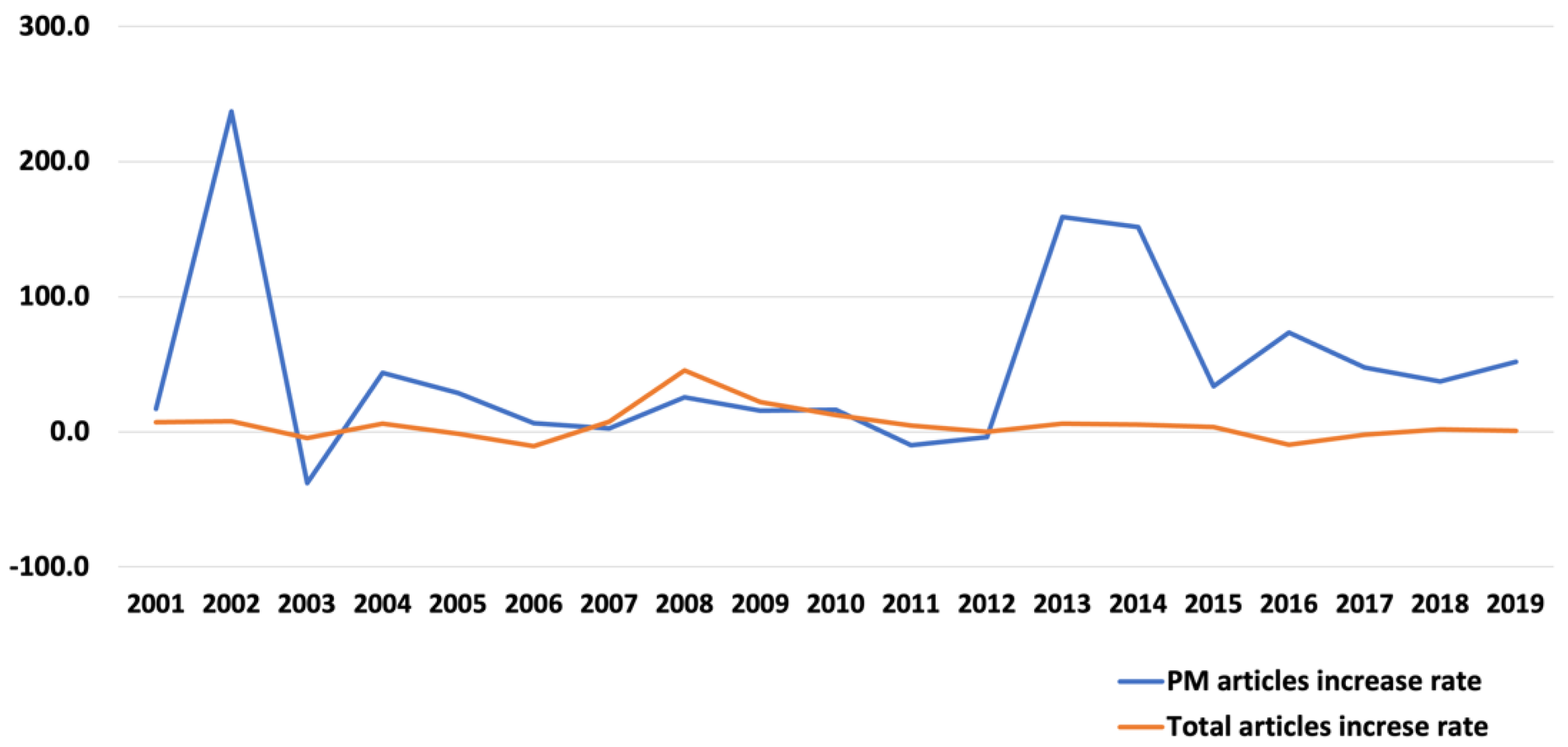
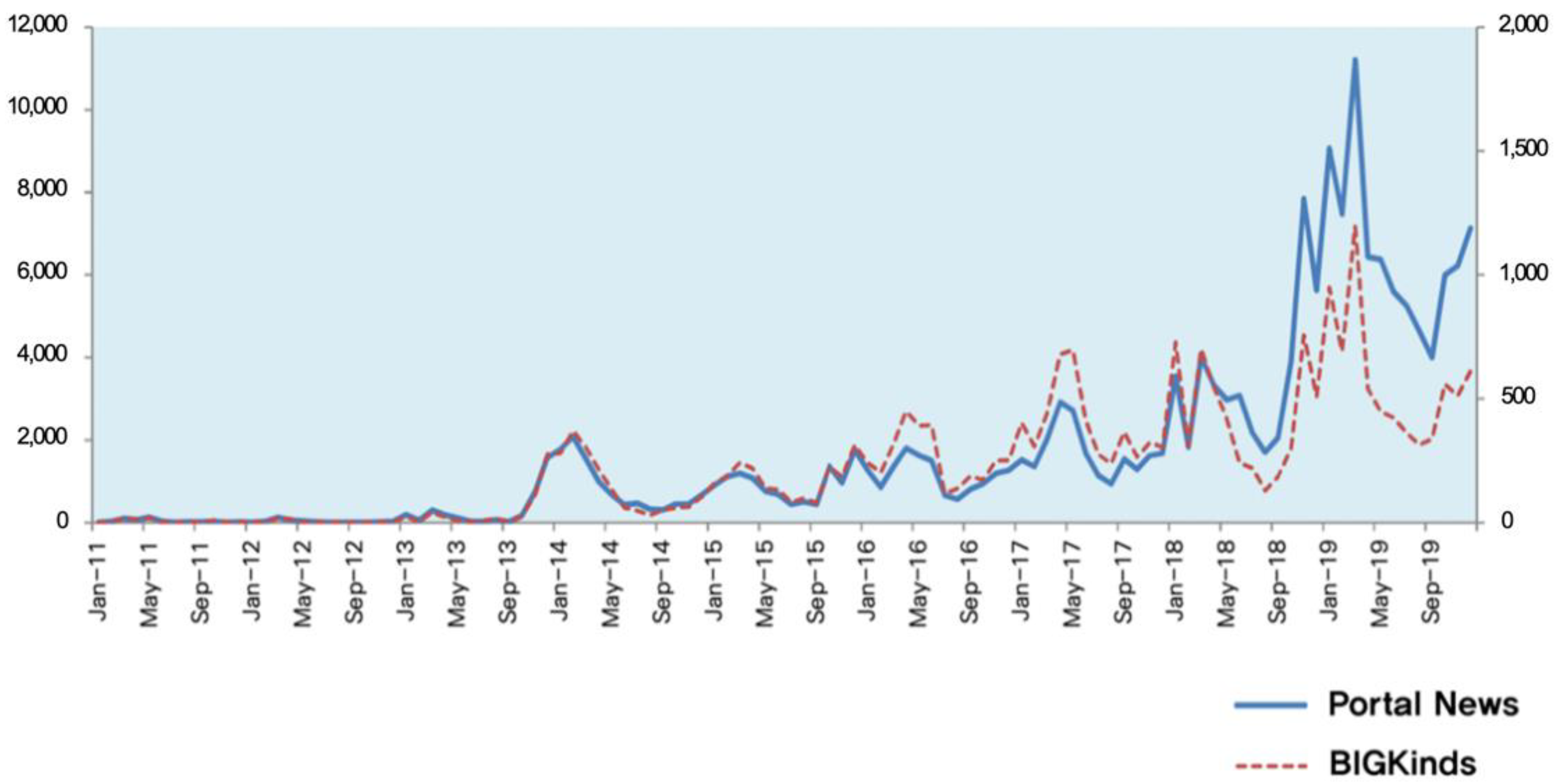
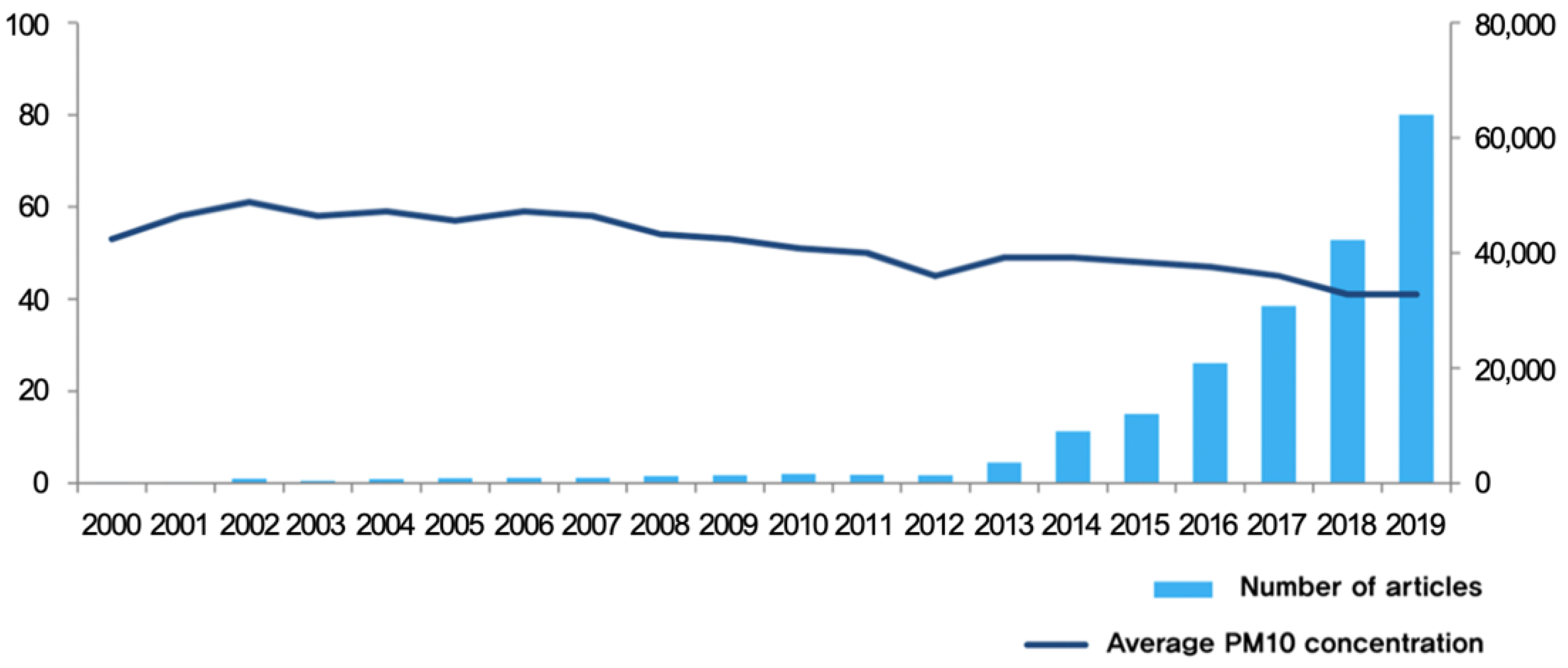
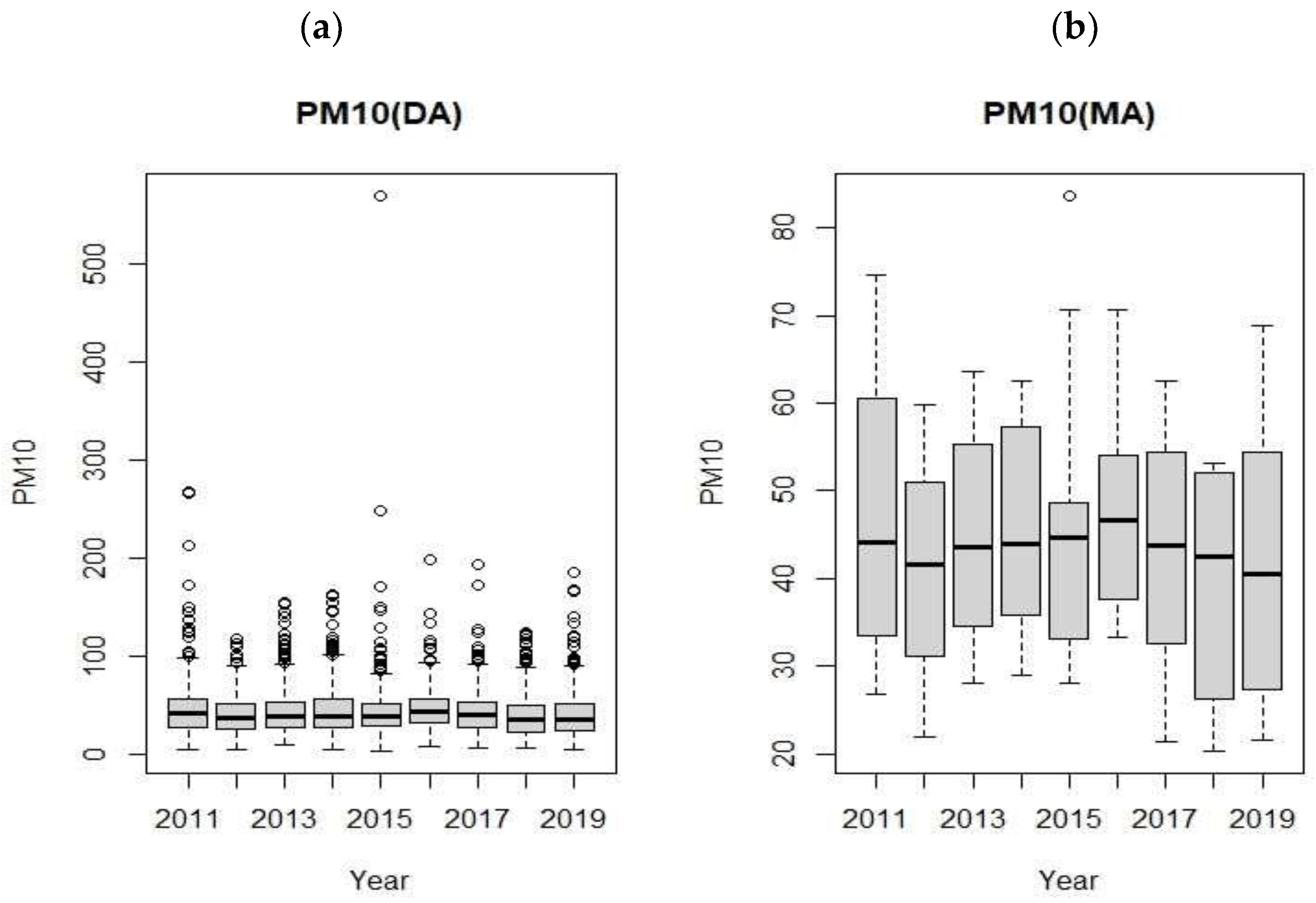
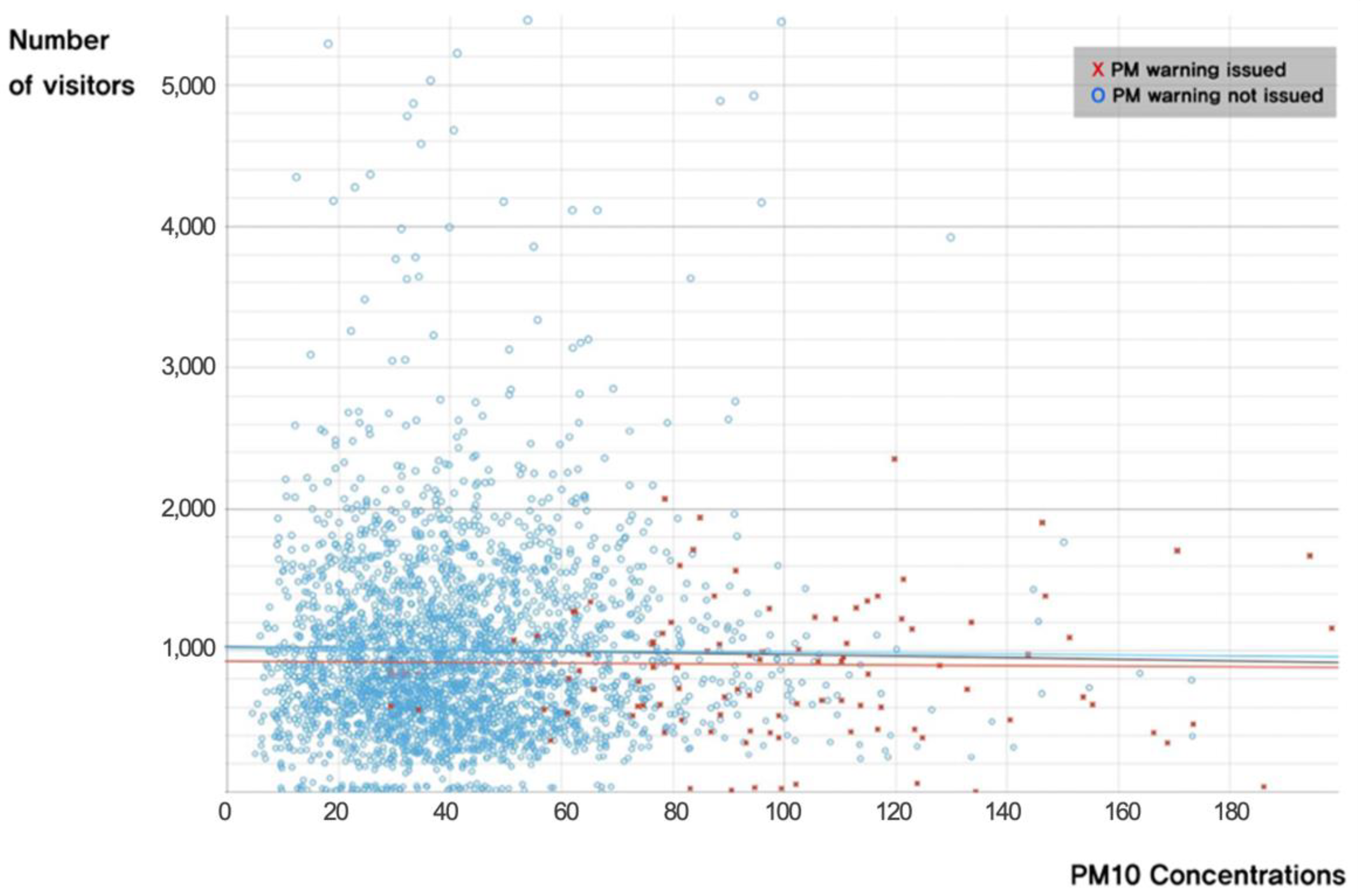
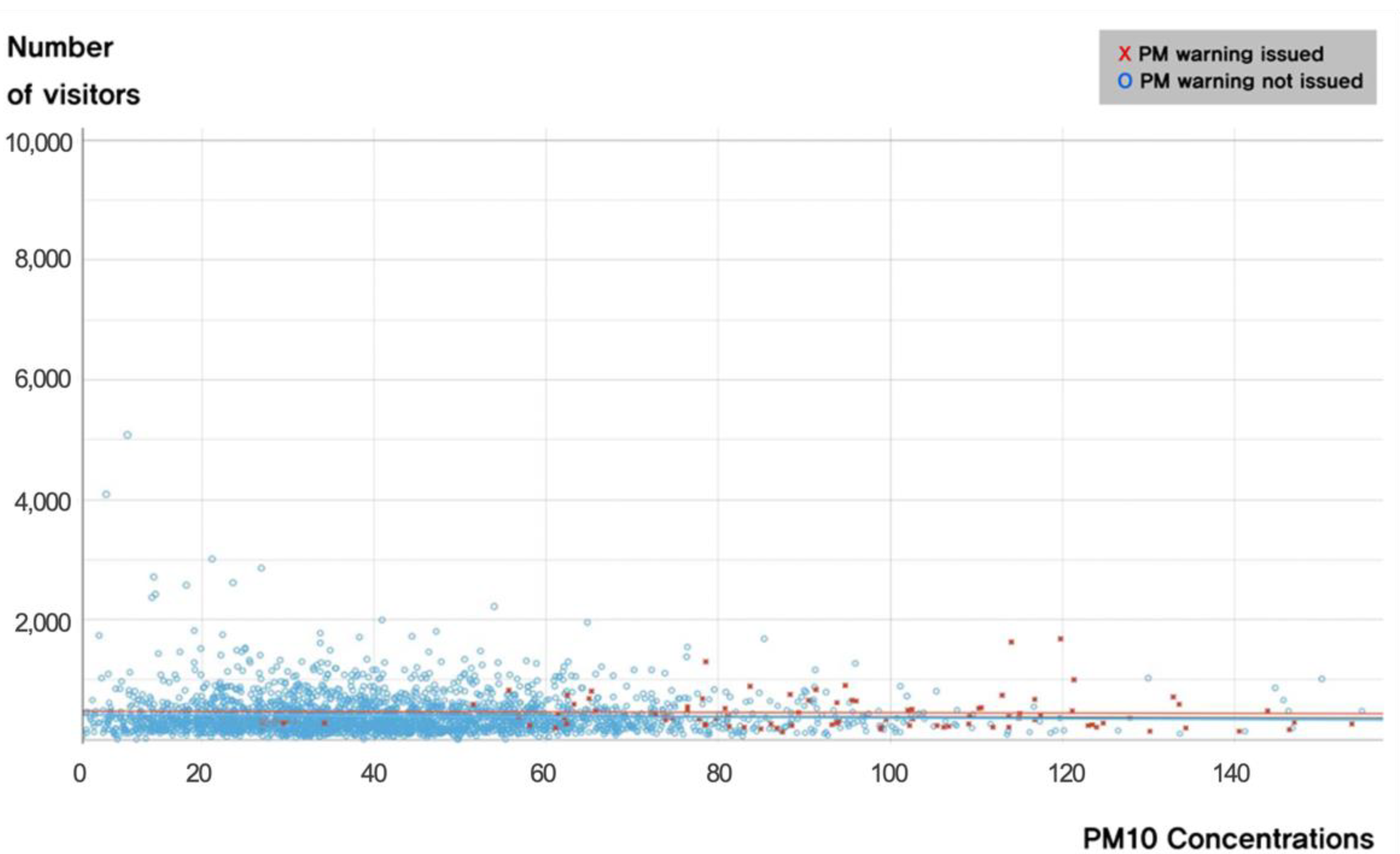
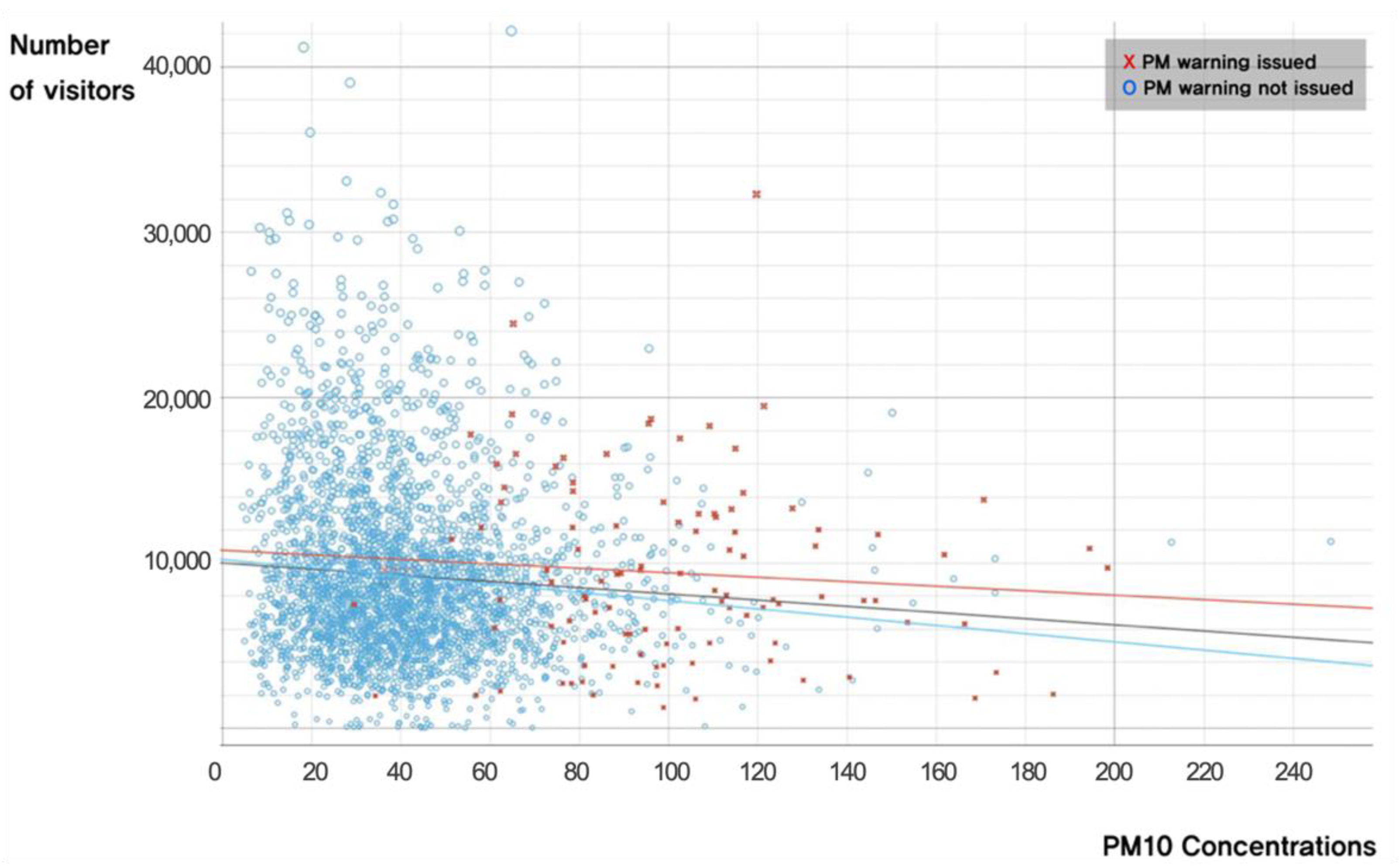
| (μg·m3, day) | |||||
|---|---|---|---|---|---|
| Good | Normal | Bad | Very Bad | ||
| PM concentration | PM10 | 0–30 | 31–80 | 81–150 | 151< |
| PM2.5 | 0–15 | 16–35 | 36–75 | 76< | |
| Year | Number of PM Articles | Total Number of Articles | Year | Number of PM Articles | Total Number of Articles |
|---|---|---|---|---|---|
| 2000 | 192 | 1,621,602 | 2010 | 1598 (+16.4%) | 3,560,302 (+12.2%) |
| 2001 | 225 (+17.2%) | 1,737,440 (+7.1%) | 2011 | 1438 (−10.0%) | 3,728,829 (+4.7%) |
| 2002 | 758 (+236.9%) | 1,871,305 (+7.7%) | 2012 | 1381 (−4.0%) | 3,726,986 (+0.0%) |
| 2003 | 470 (−38.0%) | 1,788,110 (−4.4%) | 2013 | 3577 (+159.0%) | 3,952,681 (+6.1%) |
| 2004 | 675 (+43.6%) | 1,896,248 (+6.0%) | 2014 | 9001 (+151.6%) | 4,162,294 (+5.3%) |
| 2005 | 870 (+28.9%) | 1,866,553 (−1.6%) | 2015 | 12,020 (+33.5%) | 4,309,773 (+3.5%) |
| 2006 | 924 (+6.2%) | 1,665,812 (−10.8%) | 2016 | 20,853 (+73.5%) | 3,899,939 (−9.5%) |
| 2007 | 946 (+2.4%) | 1,788,570 (+7.4%) | 2017 | 30,779 (+47.6%) | 3,822,936 (−2.0%) |
| 2008 | 1188 (+25.6%) | 2,603,433 (+45.6%) | 2018 | 42,219 (+37.2%) | 3,893,067 (+1.8%) |
| 2009 | 1373 (+15.6%) | 3,171,855 (+21.8%) | 2019 | 64,049 (+51.7%) | 3,927,089 (+0.9%) |
| Year | Concentration | Year | Concentration |
|---|---|---|---|
| 2000 | 53 | 2010 | 51 |
| 2001 | 58 | 2011 | 50 |
| 2002 | 61 | 2012 | 45 |
| 2003 | 58 | 2013 | 49 |
| 2004 | 59 | 2014 | 49 |
| 2005 | 57 | 2015 | 48 |
| 2006 | 59 | 2016 | 47 |
| 2007 | 58 | 2017 | 45 |
| 2008 | 54 | 2018 | 41 |
| 2009 | 53 | 2019 | 41 |
| Year | PM Advisory | PM Warning | ||
|---|---|---|---|---|
| Frequency of Issuance | Number of Days of Issuance | Frequency of Issuance | Number of Days of Issuance | |
| 2007 | 2 | 4 | 0 | 0 |
| 2008 | 2 | 3 | 0 | 0 |
| 2009 | 2 | 4 | 0 | 0 |
| 2010 | 1 | 3 | 0 | 0 |
| 2011 | 0 | 0 | 0 | 0 |
| 2012 | 0 | 0 | 0 | 0 |
| 2013 | 1 | 2 | 0 | 0 |
| 2014 | 2 | 4 | 0 | 0 |
| 2015 | 3 | 5 | 0 | 0 |
| 2016 | 6 | 7 | 0 | 0 |
| 2017 | 6 | 10 | 0 | 0 |
| 2018 | 5 | 5 | 1 | 1 |
| 2019 | 8 | 14 | 0 | 0 |
| Total | 38 | 61 | 1 | 1 |
| Year | Site 1 | Site 2 | Stie 3 |
|---|---|---|---|
| 2011 | 2,515,057 | 1,036,662 | 2,910,381 |
| 2012 | 3,098,350 (+23.2%) | 816,707 (−21.2%) | 2,626,093 (−9.8%) |
| 2013 | 2,941,157 (−5.1%) | 1,035,879 (+26.8%) | 2,808,088 (+6.9%) |
| 2014 | 3,657,760 (+24.4%) | 1,151,792 (+11.2%) | 3,408,851 (+21.4%) |
| 2015 | 3,347,046 (−8.5%) | 1,088,531 (−5.5%) | 2,656,691 (−22.1%) |
| 2016 | 3,122,183 (−6.7%) | 1,271,654 (+16.8%) | 3,212,143 (+20.9%) |
| 2017 | 3,336,671 (+6.9%) | 1,522,049 (+19.7%) | 3,363,889 (+4.7%) |
| 2018 | 3,425,247 (+2.7%) | 1,371,381 (−9.9%) | 3,178,236 (−5.5%) |
| 2019 | 3,874,837 (+13.1%) | 2,044,800 (+49.1%) | 3,215,697 (+1.2%) |
| Unstandardized Coefficient | Standardized Coefficient | t | p | Collinearity Statistic | |||
|---|---|---|---|---|---|---|---|
| B | Std. Error | β | Tolerance | VIF | |||
| constants | 4713.666 | 655.171 | 7.195 | 0.000 | |||
| Temperature | 175.689 | 14.185 | 0.218 | 12.386 | 0.000 | 0.907 | 1.103 |
| Precipitation | −56.493 | 11.972 | −0.087 | −4.719 | 0.000 | 0.824 | 1.213 |
| Wind speed | −381.884 | 172.794 | −0.038 | −2.210 | 0.027 | 0.956 | 1.046 |
| Sunshine duration | 253.205 | 39.454 | 0.115 | 6.418 | 0.000 | 0.872 | 1.147 |
| Holiday | 6083.789 | 305.782 | 0.333 | 19.896 | 0.000 | 0.999 | 1.001 |
| PM10 | 5.645 | 6.283 | 0.017 | 0.899 | 0.369 | 0.750 | 1.333 |
| Warning issuance | −781.918 | 905.027 | −0.016 | −0.864 | 0.388 | 0.800 | 1.250 |
| Unstandardized Coefficient | Standardized Coefficient | t | p | Collinearity Statistic | |||
|---|---|---|---|---|---|---|---|
| B | Std. Error | β | Tolerance | VIF | |||
| constants | 3625.448 | 346.387 | 10.466 | 0.000 | |||
| Temperature | 37.591 | 7.279 | 0.094 | 5.164 | 0.000 | 0.905 | 1.105 |
| Precipitation | −21.401 | 6.026 | −0.068 | −3.551 | 0.000 | 0.831 | 1.203 |
| Wind speed | −659.079 | 89.133 | −0.131 | −7.394 | 0.000 | 0.956 | 1.046 |
| Sunshine duration | 107.420 | 20.320 | 0.098 | 5.286 | 0.000 | 0.877 | 1.141 |
| Holiday | 2768.510 | 156.489 | 0.307 | 17.691 | 0.000 | 0.998 | 1.002 |
| PM10 | −5.928 | 3.479 | −0.034 | −1.704 | 0.089 | 0.764 | 1.309 |
| Warning issuance | 778.104 | 468.484 | 0.032 | 1.661 | 0.097 | 0.820 | 1.220 |
| Unstandardized Coefficient | Standardized Coefficient | t | p | Collinearity Statistic | |||
|---|---|---|---|---|---|---|---|
| B | Std. Error | β | Tolerance | VIF | |||
| constants | 7588.363 | 367.598 | 20.643 | 0.000 | |||
| Temperature | 69.409 | 7.824 | 0.141 | 8.871 | 0.000 | 0.901 | 1.110 |
| Precipitation | −11.704 | 6.365 | −0.031 | −1.839 | 0.066 | 0.828 | 1.207 |
| Wind speed | −77.187 | 95.491 | −0.013 | −0.808 | 0.419 | 0.955 | 1.047 |
| Sunshine duration | −75.489 | 21.681 | −0.056 | −3.482 | 0.001 | 0.874 | 1.144 |
| Holiday | 6008.352 | 169.331 | 0.537 | 35.483 | 0.000 | 0.999 | 1.001 |
| PM10 | −15.920 | 3.731 | −0.075 | −4.267 | 0.000 | 0.744 | 1.344 |
| Warning occurrence | 1303.524 | 491.846 | 0.045 | 2.650 | 0.008 | 0.800 | 1.250 |
| B | SE | β | t (P) | VIF | ||
|---|---|---|---|---|---|---|
| Period 1 (2011–2015) | Constants | 3753.558 | 810.561 | 4.631 (0.000) | ||
| Temperature | 196.353 | 16.793 | 0.271 | 11.693 (0.000) | 1.086 | |
| Precipitation | −44.240 | 13.041 | −0.083 | −3.392 (0.001) | 1.202 | |
| Wind speed | −338.493 | 202.028 | −0.038 | −1.675 (0.094) | 1.049 | |
| Sunshine duration | 336.122 | 47.074 | 0.169 | 7.140 (0.000) | 1.134 | |
| Holiday | 5375.496 | 364.648 | 0.328 | 14.742 (0.000) | 1.004 | |
| PM10 | 11.287 | 6.658 | 0.042 | 1.695 (0.090) | 1.231 | |
| Warning issuance | 224.673 | 1480.253 | 0.004 | 0.152 (0.879) | 1.155 | |
| R2 = 0.224, adjusted R2 = 0.221, F = 64.762 (p = 0.001) | ||||||
| Period 2 (2016–2017) | Constants | 7547.727 | 2032.690 | 3.713 (0.000) | ||
| Temperature | 192.504 | 37.789 | 0.200 | 5.094 (0.000) | 1.114 | |
| Precipitation | −82.371 | 32.470 | −0.104 | −2.537 (0.011) | 1.218 | |
| Wind speed | −721.298 | 602.206 | −0.047 | −1.198 (0.231) | 1.103 | |
| Sunshine duration | 116.399 | 104.893 | 0.045 | 1.110 (0.268) | 1.167 | |
| Holiday | 6273.455 | 813.489 | 0.290 | 7.712 (0.000) | 1.020 | |
| PM10 | −28.467 | 21.102 | −0.063 | −1.349 (0.178) | 1.569 | |
| Warning issuance | 1899.820 | 2776.437 | 0.031 | 0.684 (0.494) | 1.485 | |
| R2 = 0.142, adjusted R2 = 0.133, F = 14.682 (p = 0.001) | ||||||
| Period 3 (2018–2019) | Constants | 4782.207 | 1564.201 | 3.057 (0.002) | ||
| Temperature | 116.989 | 31.085 | 0.141 | 3.764 (0.000) | 1.231 | |
| Precipitation | −70.985 | 33.125 | −0.083 | −2.143 (0.032) | 1.318 | |
| Wind speed | −23.461 | 524.439 | −0.002 | −0.045 (0.964) | 1.104 | |
| Sunshine duration | 206.647 | 86.063 | 0.092 | 2.401 (0.017) | 1.276 | |
| Holiday | 7499.755 | 644.139 | 0.396 | 11.643 (0.000) | 1.013 | |
| PM10 | 11.069 | 17.519 | 0.030 | 0.632 (0.528) | 2.003 | |
| Warning issuance | −2625.457 | 1503.922 | −0.078 | −1.746 (0.081) | 1.762 | |
| R2 = 0.205, adjusted R2 = 0.197, F = 25.647 (p = 0.001) | ||||||
| B | SE | β | t (P) | VIF | ||
|---|---|---|---|---|---|---|
| Period 1 (2011–2015) | Constants | 2211.288 | 220.560 | 10.026 (0.000) | ||
| Temperature | 28.137 | 4.479 | 0.135 | 6.282 (0.000) | 1.098 | |
| Precipitation | −13.114 | 3.291 | −0.089 | −3.984 (0.000) | 1.190 | |
| Wind speed | −324.371 | 53.570 | −0.127 | −6.055 (0.000) | 1.048 | |
| Sunshine duration | 77.829 | 12.391 | 0.137 | 6.281 (0.000) | 1.128 | |
| Holiday | 2371.709 | 96.531 | 0.506 | 24.569 (0.000) | 1.003 | |
| PM10 | 4.992 | 1.961 | 0.058 | 2.545 (0.011) | 1.209 | |
| Warning issuance | −53.500 | 385.501 | −0.003 | −0.139 (0.890) | 1.116 | |
| R2 = 0.336, adjusted R2 = 0.333, F = 113.763 (p = 0.001) | ||||||
| Period 2 (2016–2017) | Constants | 4223.595 | 1478.308 | 2.857 (0.004) | ||
| Temperature | 87.986 | 26.902 | 0.131 | 3.271 (0.001) | 1.098 | |
| Precipitation | −54.630 | 25.316 | −0.091 | −2.158 (0.031) | 1.228 | |
| Wind speed | −502.642 | 437.781 | −0.046 | −1.148 (0.251) | 1.095 | |
| Sunshine duration | 64.665 | 78.234 | 0.034 | 0.827 (0.409) | 1.175 | |
| Holiday | 3697.079 | 590.782 | 0.242 | 6.258 (0.000) | 1.027 | |
| PM10 | −35.862 | 15.551 | −0.107 | −2.306 (0.021) | 1.492 | |
| Warning issuance | 2031.193 | 2022.684 | 0.046 | 1.004 (0.316) | 1.418 | |
| R2 = 0.094, adjusted R2 = 0.084, F = 9.243 (p = 0.001) | ||||||
| Period 3 (2018–2019) | Constants | 2959.577 | 688.657 | 4.298 (0.000) | ||
| Temperature | 27.791 | 13.564 | 0.081 | 2.049 (0.041) | 1.223 | |
| Precipitation | −32.718 | 14.883 | −0.089 | −2.198 (0.028) | 1.288 | |
| Wind speed | −43.228 | 229.515 | −0.007 | −0.188 (0.851) | 1.109 | |
| Sunshine duration | 142.983 | 37.905 | 0.152 | 3.772 (0.000) | 1.260 | |
| Holiday | 2954.598 | 277.816 | 0.384 | 10.635 (0.000) | 1.015 | |
| PM10 | 3.614 | 7.700 | 0.023 | 0.469 (0.639) | 1.895 | |
| Warning issuance | −300.427 | 645.596 | −0.022 | −0.465 (0.642) | 1.684 | |
| R2 = 0.200, Adjusted R2 = 0.191, F = 22.238 (p = 0.001) | ||||||
| B | SE | β | t (P) | VIF | ||
|---|---|---|---|---|---|---|
| Period 1 (2011–2015) | Constants | 7678.537 | 534.792 | 14.358 (0.000) | ||
| Temperature | 99.039 | 10.865 | 0.204 | 9.115 (0.000) | 1.101 | |
| Precipitation | −14.075 | 7.840 | −0.042 | −1.795 (0.073) | 1.189 | |
| Wind speed | −146.874 | 129.210 | −0.025 | −1.137 (0.256) | 1.050 | |
| Sunshine duration | −108.344 | 29.883 | −0.082 | −3.626 (0.000) | 1.129 | |
| Holiday | 5379.336 | 232.794 | 0.494 | 23.108 (0.000) | 1.003 | |
| PM10 | −9.917 | 4.704 | −0.050 | −2.108 (0.035) | 1.212 | |
| Warning issuance | 2046.623 | 917.616 | 0.050 | 2.230 (0.026) | 1.118 | |
| R2 = 0.302, adjusted R2 = 0.299, F = 94.696 (p = 0.001) | ||||||
| Period 2 (2016–2017) | Constants | 9485.285 | 834.043 | 11.373 (0.000) | ||
| Temperature | −23.133 | 15.443 | −0.047 | −1.498 (0.135) | 1.116 | |
| Precipitation | −7.181 | 13.478 | −0.017 | −0.533 (0.594) | 1.227 | |
| Wind speed | −129.007 | 247.430 | −0.016 | −0.521 (0.602) | 1.105 | |
| Sunshine duration | −67.234 | 43.962 | −0.049 | −1.529 (0.127) | 1.170 | |
| Holiday | 6992.099 | 343.490 | 0.608 | 20.356 (0.000) | 1.018 | |
| PM10 | −33.640 | 8.819 | −0.140 | −3.814 (0.000) | 1.537 | |
| Warning issuance | 1165.574 | 1140.712 | 0.036 | 1.022 (0.307) | 1.453 | |
| R2 = 0.386, adjusted R2 = 0.380, F = 63.056 (p = 0.001) | ||||||
| Period 3 (2018–2019) | Constants | 7352.828 | 822.664 | 8.938 (0.000) | ||
| Temperatures | 84.479 | 16.393 | 0.169 | 5.153 (0.000) | 1.228 | |
| Precipitation | −11.264 | 17.670 | −0.022 | −0.637 (0.524) | 1.312 | |
| Wind speed | −519.714 | 273.991 | −0.059 | −1.897 (0.058) | 1.113 | |
| Sunshine duration | 32.538 | 45.428 | 0.024 | 0.716 (0.474) | 1.270 | |
| Holiday | 6429.616 | 344.812 | 0.557 | 18.647 (0.000) | 1.013 | |
| PM10 | −27.379 | 9.145 | −0.125 | −2.994 (0.003) | 1.969 | |
| Warning issuance | 2122.759 | 784.989 | 0.106 | 2.704 (0.007) | 1.737 | |
| R2 = 0.373, adjusted R2 = 0.367, F = 60.544 (p = 0.001) | ||||||
Publisher’s Note: MDPI stays neutral with regard to jurisdictional claims in published maps and institutional affiliations. |
© 2022 by the authors. Licensee MDPI, Basel, Switzerland. This article is an open access article distributed under the terms and conditions of the Creative Commons Attribution (CC BY) license (https://creativecommons.org/licenses/by/4.0/).
Share and Cite
Shin, Y.; Kim, S.; Park, J.; Lee, S.-W.; An, K. Effectiveness of Particulate Matter Forecasting and Warning Systems within Urban Areas. Sustainability 2022, 14, 5394. https://doi.org/10.3390/su14095394
Shin Y, Kim S, Park J, Lee S-W, An K. Effectiveness of Particulate Matter Forecasting and Warning Systems within Urban Areas. Sustainability. 2022; 14(9):5394. https://doi.org/10.3390/su14095394
Chicago/Turabian StyleShin, Yeeun, Suyeon Kim, Jinsil Park, Sang-Woo Lee, and Kyungjin An. 2022. "Effectiveness of Particulate Matter Forecasting and Warning Systems within Urban Areas" Sustainability 14, no. 9: 5394. https://doi.org/10.3390/su14095394
APA StyleShin, Y., Kim, S., Park, J., Lee, S.-W., & An, K. (2022). Effectiveness of Particulate Matter Forecasting and Warning Systems within Urban Areas. Sustainability, 14(9), 5394. https://doi.org/10.3390/su14095394







